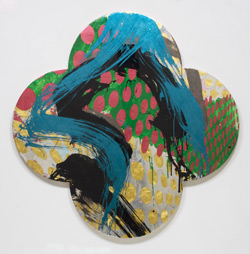Max Gimblett The Sound of One Hand is the fourth exhibition in The Word of God series, which examines major world religions and their texts through the lens of contemporary art.
The Word of God: Max Gimblett The Sound of One Hand
September 17 – November 27, 2011
Sacred texts are considered by many to be the direct words of God to man. How this Word is passed down and received has been dependent on the cultures in which it is presented. This series explores the myriad of ways humans have sought to understand the Word of God and to pass it on through practice, text and imagery. In the case of New York artist Max Gimblett, Zen Buddhism is the tradition and the sacred texts are koans. A koan is a statement or question that can not be fully understood through rational thought alone. Koan study is a unique method of religious practice intended to bring the student to the direct, intuitive realization of the Ultimate Principle or Absolute Mind. A well-known koan example and the inspiration for the exhibition title is, Two hands meet and there is a sound; what is the sound of one hand? Featured in the exhibition are two of Gimblett’s koan books, Sage which includes ink drawings by the artist and koans from the book, The Zen Koan a series of published lectures on koan study by Roshi Isshu Miura. A Book of Broadway Koans is also on view which includes original drawings by Gimblett and poems by John Yau.
Gimblett’s paintings are born out of both Eastern and Western Philosophies about light and enlightenment. He is influenced by the Abstract Expressionist tradition of gestural painting as well as the art discipline of Sumi ink calligraphy. The process of painting is reverent; each splatter, drip, and stroke is imbued with the spiritual motion taught by Sumi masters. The shape of the stroke, the action and the expression are all tied into a meditative process. Using diverse pigments, resins, and precious metals, Gimblett creates surfaces that are transformed synonymous with the transformation of energy into spiritual thought.
Like the marks made, each of Gimblett’s canvases caries a symbolic meaning in its very shape. These shaped canvases whether circle, square, or quatrefoil with four equal domed sides, the contoured shapes reflect balance in relation to space, time and Zen thought. One of Gimblett’s most unique canvas shapes is the Enso. Ensō is a Japanese word meaning “circle” and is one of the tenets of Zen. Typically drawn in one stroke with a thick paintbrush, the enso represents absolute reality and the void in Zen art. The single stroke does not allow for any modification – the brushed circle represents the spirit of the moment of creation. Gimblett transforms this powerful circle into physical form while repeating it in ink and paint on endless surfaces.
Gimblett created new paintings for this exhibition demonstrating not only his interest in Warhol and the environment of the Museum but also his adventurous nature and intense love for work itself. “My art evolves. It’s different every year. At 75 I am no longer preoccupied with self. That’s been discovered and put aside. Now it’s not-self. There are new hybrid languages being born all the time and my work changes and shifts [. . .] There’s still much to do.” (Interviewed by Christopher Moore, The Press, Christchurch, NZ, March 13, 2011)
The Word of God Exhibitions and Project:
At a time when political parties fight viciously for the higher moral ground, when controversy reigns in the building of mosques, and when bigotry, abortion, and same-sex marriage are wedges of division in our culture there still remains room for interfaith understanding. The Warhol has, in its sixteen year history, presented difficult or controversial imagery and art in order to spark community dialogue. The dialogues and visitor experiences from such encounters with art and images are powerful and potentially community changing.
Exhibition Related Programs: Symposiums, Artist Talks, Gallery Talks, Lectures, Public Dialogs, Poetry Readings, Youth Programs, and special Weekend Factory themes. Follow us on Facebook and Twitter for developing details.

Homepage Images:Max Gimblett, The Princess Mnemosyme, 2011Max Gimblett, Diogene, 2011 This page:Max Gimblett, Enigma - after Sigmar Polke, 2011

